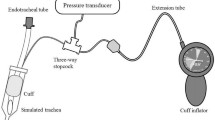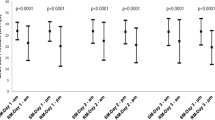Abstract
The tracheal tube cuff performs an important function during anesthesia and critical care situations by allowing positive pressure ventilation and isolating the lungs from aspiration. Other maneuvers, such as pressure support ventilation and positive end-expiratory pressure, are also cuff-dependent. However, excessive cuff pressure, as well as long-term intubation without excessive cuff pressure, have been associated with significant morbidity and mortality. A straightforward mathematical model of differential tracheal tube cuff pressure has been developed. This model incorporates compliance, temperature variation, and net molar diffusion in determining differential tracheal tube cuff pressure. In addition, temperature and diffusion are modeled as separate processes which effect differential cuff pressure independently. Support for the validity of this model is based upon an analysis of existing data from prior studies.
Similar content being viewed by others
References
Reed MF, Mathisen DJ. Tracheoesophageal fistula. Chest Surg Clin N Am 2003; 13(2): 271–289.
Deslee G, Brichet A, Lebuffe G, Copin MC, Ramon P, Marquette CH. Obstructive fibrinous tracheal pseudomembrane. A potentially fatal complication of tracheal intubation. Am J Resp Crit Care 2000; 162: 1169–1171.
Harris R, Joseph A. Acute tracheal rupture related to endotracheal intubation: Case report. J Emerg Med January 2000: 35–39.
Tu H, Saidi N, Lieutaud T, Bensaid S, Menival V, Duvaldestin P. Nitrous oxide increases endotracheal cuff pressure and the incidence of tracheal lesions in anesthetized patients. Anesth Analg 1999; 89(1): 187–190.
Bartels HE, Stein HJ, Siewert JR. Tracheobronchial lesions following oesophagectomy: Prevalence, predisposing factors and outcome. Brit J Surg 1998; 85(3): 403–406.
Schaefer OP, Irwin RS. Tracheoarterial fistula: An unusual complication of tracheostomy. J Intensive Care Med 1995; 10(2): 64–75.
Grillo HC, Donahue DM, Mathisen DJ, Wain JC, Wright CD. Postintubation tracheal stenosis: Treatment and results. J Thorac Cardiov Surg 1995; 109(3): 486–492.
Wood DE, Mathisen DJ. Late complications of tracheotomy. Clin Chest Med 1991; 12(3): 597–609.
Hafez A, Couraud L, Velly JF, Bruneteau A. Late cataclysmic hemorrhage from the innominate artery after tracheostomy. Thorac Cardiov Surg 1984; 32(5): 315–319.
Rubio PA, Farrell EM, Bautista EM. Severe tracheal stenosis after brief endotracheal intubation. South Med J 1979; 72(12): 1628–1629.
Klainer AS, Turndorf H, We WH, Maewal H, Allender P. Surface alterations due to endotracheal intubation. Am J Med 1975; 58(5): 674–683.
McHardy FE, Chung F. Postoperative sore throat: cause, prevention and treatment. Anaesthesia 1999; 54(5): 444–453.
Mehta S. Effects of nitrous oxide and oxygen on tracheal tube cuff gas volumes. Brit J Anaesth 1981; 53(11): 1227–1231.
Dullenkopf A, Gerber AC, Weiss M. Nitrous oxide diffusion into tracheal tube cuffs: Comparison of five different tracheal tube cuffs. Acta Anaesth Scand 2004; 48: 1180–1184.
Inada T, Kawachi S, Kuroda M. Tracheal tube cuff pressure during cardiac surgery using cardiopulmonary bypass. Br J Anaesth 1995; 74: 283–286.
Souza Neto EP, Piriou V, Durand PG, George M, Evans R, Obadia JF, Lehot JJ. Influence of temperature on tracheal tube cuff pressure during cardiac surgery. Acta Anaesth Scand 1999; 43: 333–337.
Ikeda S, Schweiss JF. Tracheal tube cuff volume changes during extracorporeal circulation. Can Anaesth Soc J 1980; 27(5): 453–457.
Patel RI, Oh TH, Chandra R, Epstein BS. Tracheal tube cuff pressure. Anaesthesia 1984; 39: 862–864.
Karasawa F, Tokunaga M, Aramaki Y, Shizukuishi M, Satoh T. An assessment of a method of inflating cuffs with a nitrous oxide gas mixture to prevent an increase in intracuff pressure in five different tracheal tube designs. Anaesthesia 2001; 56(2): 155–159.
Raeder JC, Borchgrevink PC, Sellevold OM. Tracheal tube cuff pressures. Anaesthesia 1985; 40: 444–447.
Revenäs B, Lindhom C-E. Pressure and volume changes in tracheal tube cuffs during anaesthesia. Acta Anaesth Scand 1976; 20: 321–326.
Vyas D, Inweregbu K, Pittard A. Measurement of tracheal tube cuff pressure in critical care. Anaesthesia 2002; 57(3): 275–277.
Kim JM, Mangold JV, Hacker DC. Laboratory evaluation of low-pressure tracheal tube cuffs: Large-volume versus low-volume. Br J Anaesth 1985; 57: 913–918.
Mazumdar J. An Introduction to Mathematical Physiology and Biology. Chapter 2. The Mathematics of Diffusion. Australian Mathematical Society Lecture Series 4. Cambridge University Press, 1989.
Author information
Authors and Affiliations
Corresponding author
Rights and permissions
About this article
Cite this article
Atlas, G.M. A Mathematical Model of Differential Tracheal Tube Cuff Pressure: Effects of Diffusion and Temperature. J Clin Monit Comput 19, 415–425 (2005). https://doi.org/10.1007/s10877-005-1626-5
Received:
Accepted:
Published:
Issue Date:
DOI: https://doi.org/10.1007/s10877-005-1626-5




